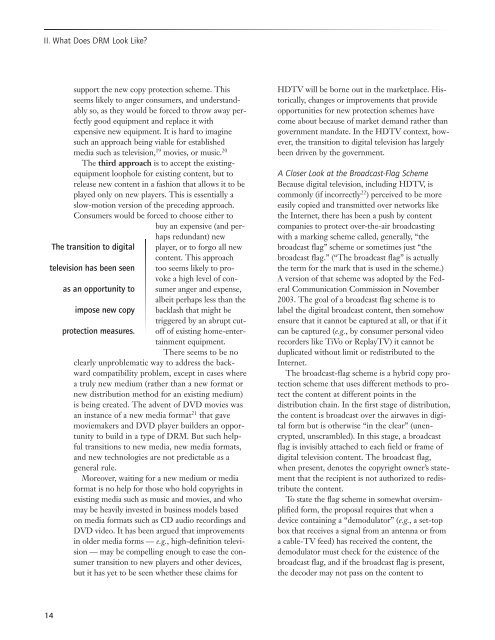What Every Citizen Should Know About DRM, aka - Public Knowledge
What Every Citizen Should Know About DRM, aka - Public Knowledge
What Every Citizen Should Know About DRM, aka - Public Knowledge
You also want an ePaper? Increase the reach of your titles
YUMPU automatically turns print PDFs into web optimized ePapers that Google loves.
II. <strong>What</strong> Does <strong>DRM</strong> Look Like?support the new copy protection scheme. Thisseems likely to anger consumers, and understandablyso, as they would be forced to throw away perfectlygood equipment and replace it withexpensive new equipment. It is hard to imaginesuch an approach being viable for establishedmedia such as television, 19 movies, or music. 20The third approach is to accept the existingequipmentloophole for existing content, but torelease new content in a fashion that allows it to beplayed only on new players. This is essentially aslow-motion version of the preceding approach.Consumers would be forced to choose either tobuy an expensive (and perhapsredundant) newThe transition to digital player, or to forgo all newcontent. This approachtelevision has been seen too seems likely to provokea high level of consumeranger and expense,as an opportunity toalbeit perhaps less than theimpose new copy backlash that might betriggered by an abrupt cutoffof existing home-enter-protection measures.tainment equipment.There seems to be noclearly unproblematic way to address the backwardcompatibility problem, except in cases wherea truly new medium (rather than a new format ornew distribution method for an existing medium)is being created. The advent of DVD movies wasan instance of a new media format 21 that gavemoviemakers and DVD player builders an opportunityto build in a type of <strong>DRM</strong>. But such helpfultransitions to new media, new media formats,and new technologies are not predictable as ageneral rule.Moreover, waiting for a new medium or mediaformat is no help for those who hold copyrights inexisting media such as music and movies, and whomay be heavily invested in business models basedon media formats such as CD audio recordings andDVD video. It has been argued that improvementsin older media forms — e.g., high-definition television— may be compelling enough to ease the consumertransition to new players and other devices,but it has yet to be seen whether these claims forHDTV will be borne out in the marketplace. Historically,changes or improvements that provideopportunities for new protection schemes havecome about because of market demand rather thangovernment mandate. In the HDTV context, however,the transition to digital television has largelybeen driven by the government.A Closer Look at the Broadcast-Flag SchemeBecause digital television, including HDTV, iscommonly (if incorrectly 22 ) perceived to be moreeasily copied and transmitted over networks likethe Internet, there has been a push by contentcompanies to protect over-the-air broadcastingwith a marking scheme called, generally, “thebroadcast flag” scheme or sometimes just “thebroadcast flag.” (“The broadcast flag” is actuallythe term for the mark that is used in the scheme.)A version of that scheme was adopted by the FederalCommunication Commission in November2003. The goal of a broadcast flag scheme is tolabel the digital broadcast content, then somehowensure that it cannot be captured at all, or that if itcan be captured (e.g., by consumer personal videorecorders like TiVo or ReplayTV) it cannot beduplicated without limit or redistributed to theInternet.The broadcast-flag scheme is a hybrid copy protectionscheme that uses different methods to protectthe content at different points in thedistribution chain. In the first stage of distribution,the content is broadcast over the airwaves in digitalform but is otherwise “in the clear” (unencrypted,unscrambled). In this stage, a broadcastflag is invisibly attached to each field or frame ofdigital television content. The broadcast flag,when present, denotes the copyright owner’s statementthat the recipient is not authorized to redistributethe content.To state the flag scheme in somewhat oversimplifiedform, the proposal requires that when adevice containing a “demodulator” (e.g., a set-topbox that receives a signal from an antenna or froma cable-TV feed) has received the content, thedemodulator must check for the existence of thebroadcast flag, and if the broadcast flag is present,the decoder may not pass on the content to14





